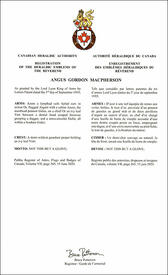The contents of this Register are intended for research purposes only. The heraldic emblems found in the Register may not be reproduced in any form or in any media without the written consent of the Canadian Heraldic Authority and/or the recipient.
Toronto, Ontario
Registration of Arms
June 15, 2020
Vol. VII, p. 265
Arms of Angus Gordon MacphersonBlazonAzure a lymphad sails furled oars in action Or, flagged Argent with a saltire Azure, the masthead pennon Gules, on a chief Or an ivy leaf Vert between a dexter hand couped fesswise grasping a dagger, and a cross-crosslet fitché, all within a bordure Gules; SymbolismThe colours, the ship, the hand holding the dagger, and the cross are taken from the arms of the chief of the Clan Macpherson. The ship, derived from the arms of the Lords of the Isles, is found in many coats of arms from the western Highlands of Scotland. The flags on the ship allude to that of Nova Scotia, where Dr. Macpherson was born. The cross is an ecclesiastical reference, as the name Macpherson is derived from the Scots Gaelic phrase for “son of the parson.” The hand and dagger indicate the role of the Clan Macpherson in overthrowing the Cummings of Badenoch family, who were enemies of King Robert I of Scotland at the beginning of the 14th century. The ivy leaf is the plant badge of the Clan Gordon, Gordon being one of the names used by Dr. Macpherson. In the Scottish system of cadency, the red border indicates that Dr. Macpherson is the fourth son in his family. |
CrestBlazonA demi-wildcat guardant proper holding an ivy leaf Vert; SymbolismThe wildcat is used as a crest by most Macpherson armigers. The ivy leaf is taken from the Arms. |
MottoBlazonNOT THIS BUT A GLOVE; SymbolismThis phrase is a variation on the motto of the chief of the Clan Macpherson, “Touch not the cat but a glove.” The glove refers to the pads of a wildcat’s paws when its claws have been retracted. The phrase is therefore a warning not to engage with the members of the clan—represented by the wildcat—when they are ready to fight, or “ungloved.” |
Additional InformationCreator(s)Not available PainterNot applicable CalligrapherNot applicable Recipient TypeIndividual Other InformationThe recipient’s emblems were originally recorded in the records of the Court of the Lord Lyon, Edinburgh, Scotland, 3 September 1955. |



